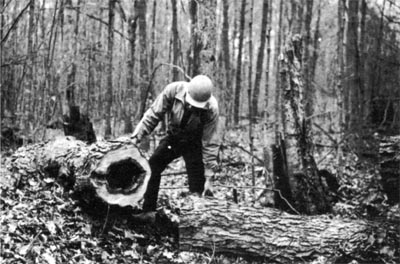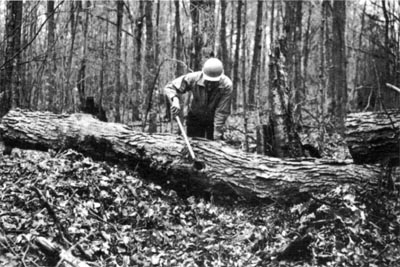
| Home |
| Tutorial |
| Photo Gallery |
| List of Defects |
| Links |
| Bark Distortion |
| Bird Peck |
| Bumps |
| Burls |
| Butt Scars |
| Butt Swells |
| Cankers |
| Conks |
| Epicormic Branches |
| Flanges |
| Flutes |
| Forks |
| Galls |
| Holes |
| Knots |
| Lesions |
| Limbs |
| Ring Shake |
| Rot |
| Seams |
| Soak |
| Splits |
| Wounds |
Large holes are unoccluded openings into the bole more than one-half inch (1.3 cm) in diameter. Some causes of these holes are decayed knots, woodpeckers excavating insect larvae or rotten areas, and mechanical damage. 
Significance: Large holes are log grade defects in certain classes of logs and in others, depending on their size and depth, in relation to diameter of the log.
In veneer logs, all large holes are grading defects. Large holes in a log exclude it from the production of face veneer. Logs yielding veneer with holes that can be patched are acceptable for the manufacture of plywood panel backs, container veneer, and corestock.
In factory logs, all large holes are log grade defects because they constitute defects in both clear-face and sound cuttings in all grades of lumber.
In construction logs, large holes are degraders if their size is more than one-third the diameter of the log at the point of occurrence, or if, regardless of size, they extend more than 3 inches (7.6 cm) into the included timber. If they are smaller or shallower than this and if they are enclosed by sound wood, they can be disregarded.
In standing trees, large holes always are defects and call for further examination of the tree stem because of the wide range of additional degrade that they may indicate. A large hole may represent only the channel of the decomposed limb from which it came, or it may lead into a large mass of interior rot or stain. At other times, it may indicate an extensive hollow either being used or having been used as a nesting place or den.
Medium Holes:
Medium holes are unoccluded openings in the bark, 3/16 to 1/2 inch (0.5 to 1.3 cm) in diameter, which sometimes penetrate into the wood beneath. They include entrance and emergence holes of wood-boring insects, increment-borer and tap holes, and openings made by sapsuckers.
It is not difficult to determine the origin of the holes. Holes from wood-boring insects are caused by roundheaded borers (Goes spp.) and the carpenterworm (Prionoxystus robiniae). Their galleries are clean cut and usually stained, always penetrate more than 1 inch (2.5 cm) into the wood, are spaced irregularly, and extend upward through the wood. If these holes have remained open, there has been subsequent activity by other insects, usually the carpenter ant (Camponotus pennsylvanicus). In such cases, decay fungi enter, and the ants excavate the rotten wood and enlarge the galleries to make their nest cavities. Associated with these are ingrown bark and callus tissue.
Recent or fresh attacks by the bark scarrer such as the oak-bark scarrer (Enaphalodes cortiphagus) appear as open holes about one-quarter inch (0.6 cm) or less in diameter. They are identified by their round, irregular outline and by their nonpenetration of the wood. The work of the bark scarrer and borers results in a frothy exudation, which turns a dirty brown.
Increment-borer and tap holes are of the same general character as wood borer holes but do not spread and branch. Sapsucker holes usually are found in rows or bands, which may partially or completely encircle the bole. Occasionally, the entire log or tree stem is freckled with them. The holes usually extend only slightly, if at all into wood.
Significance: Medium holes may not be a degrader in any class of logs except veneer logs if only one cause is present. However, they are found in combination so often, and with other degraders (stain and bark pockets), they pose a serious threat to log quality in all log classes except local use.
In veneer logs, all medium holes are log grade defects. Borer holes- whether or not associated with carpenter ant damage, increment borer-holes, and tap holes- result in the rejection of a log for the production of face veneer. Stain usually accompanies each type. Birdpeck excludes a log for face veneer because stain and small bark pockets are commonly associated with it. Medium holes are admitted in logs for the production of plywood panel backs, corestock, and container veneer.
In factory logs, boring-insect holes, increment-borer holes, and tap holes are all grading defects because the hole or gallery in the lumber limits the length and width of cuttings. The carpenter ant often enlarges these openings; this increases the degrading effect.
In construction logs, medium holes are seldom log grade defects. In some areas, boring-insect attacks may be so serious that the logs are rejected for timbers and railroad ties. Such damamge has been observed in black and scarlet oak that had been attacked repeatedly by the carpenterworm (E. rufulus).
In standing trees, the indicators of medium holes must be examined and appraised carefully. Roundheaded borers and bark scarrers cause serious damage in oak and less serious damage in ash, beech, cottonwood, hickory, black locust, maple, and pecan. Carpenter ants increase the severity of the borer damage in the oak.
Increment-borer and tap holes usually are accompanied by severe stain. In addition, tap holes have so often contained forgotten metal sprouts that butt logs usually are "jumped" when a metal detector is not used at the mill. Since the introduction of plastic spouts, however, this problem has been eliminated.
Bark scarrer holes, if identifiable, can be disregarded in all classes of logs because the holes are superficial and often do not even penetrate the wood. Fresh holes show exudations and stained bark. Caution is necessary here because earlier attacks likely have occurred where holes are present.
Small Holes
Small holes are unoccluded openings less than three-tenths of an inch (0.8 cm) in diameter leading into the wood. These holes are often caused by insects of several genera of beetles, especially the ambrosia beetles.
Significance: Small holes on the surface of a tree or log often are accompanied by other features such as wounds or sap rot that at times cause log grade defects.
In veneer logs, small holes cause a log to be rejected for face production if their sum exceeds one standard defect. However, unless logs of veneer quality contain large concentrations of small holes in a restricted area, they are accepted for the production of plywood panel backs, corestock, and container veneer.
In factory logs, the usual effect of small holes is to increase the already defective area occupied by the rot or wound. Nevertheless, even if not otherwise defective, the area in which boring insects or bark scarrers work is a degraded area, and the potential yield of clear-face cuttings is lessened.
In construction logs, small holes are disregarded.

